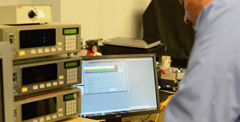
Minolta Calibration
As with all precision instruments, Konica Minolta Sensing’s measuring instruments require regular calibration to maintain optimum performance within the manufacturer’s specifications and tolerances.
Konica Minolta Sensing’s state of the art calibration laboratory ensures that your instruments are always working at peak performance. Konica Minolta’s service facility is dedicated to providing quality, performance, and value.
What is Calibration?
Calibration is the comparison between measurement results
of a device (unit under test) and another (standard) device with known or assigned values. Both
daily instrument calibration and annual
calibration are important to maintaining consistent and reliable readings from your Konica Minolta
instruments.
Why is calibration important?
Over time, there is a tendency for results and
accuracy to drift. Calibration quantifies and controls errors or uncertainties within measurement
processes to an acceptable level. To be
confident in the results being measured, it is imperative to maintain the calibration of equipment
throughout its lifetime for reliable, accurate, and repeatable measurements.
Daily Calibration
What is Daily Calibration?
Daily calibration is a procedure that is designed for the instrument operator to bring the instrument to a known state utilizing a factory supplied reference standard of traceable values.
The procedure for daily calibration is simple and straightforward. Two measurements are taken with the instrument, one measurement of a ceramic white standard with traceable values, and one measurement of absolute black.
The measurement of the white ceramic standard must always be performed with the standard that was assigned to the respective instrument. Each white standard is serialized and therefore easily paired with the correct instrument. The absolute black measurement, referred to as a 'zero calibration' or 'black trap measurement' can be performed by utilizing a special attachment for the instrument which absorbs all light (black trap, or zero calibration box), or by taking a measurement with nothing in front of the instruments measurement port for at least 3ft (open port black calibration). In either scenario the end result is the same in that no light will be reflected back into the instrument and therefore the measurement result will be of an absolute black.
Both the white standard reading and the absolute black reading are utilized by the instruments onboard processor to set the instrument to a known state of calibration.
How often should daily calibration be performed by the operator of the instrument?
Daily calibration of color measurement devices should be performed in the same environment and conditions as the measurements with the device will be taken. The instrument and its calibration standard should be given sufficient time to acclimatize to the environment where calibration and measurement will occur. Typically with stationary instruments a minimum interval that daily calibration should be performed is every 8 hours or every shift. However there are various cases where daily calibration should be performed more often such as:
- If the environmental conditions of temperature and humidity change. The calibration process allows the operating environment to be taken into account to provide consistent results.
- If the measurement mode of the instrument is changed, for example specular component, reflectance, transmittance, etc.
- If the aperture size of the instrument is changed.
If you have any questions on calibration interval please consult the user's manual of the instrument or with Konica Minolta's team of application engineers, they can recommend the optimum calibration interval based on your specific measurement requirements. Keep in mind, daily calibration only takes a matter of seconds, so when in doubt, re-calibrate!
There are several important considerations when performing daily calibration of color measurement devices, they can be summarized as:
- Ensure the white calibration tile is free from scratches, dirt, or fingerprints. Any debris or abnormality can affect the calibration of the device in question.
- Ensure the white calibration tile is seated correctly to the instruments measurement aperture. Any angular misalignment can cause variation in the measurement of the calibration standard and introduce error.
- Ensure you are utilizing the correct white calibration standard for your device.
- For black calibration utilizing a zero calibration box ensure that the zero calibration box, or black trap, is free from dust and debris.
- For black calibration utilizing an open port calibration, ensure that there is no objects in front of the instruments measurement port less than three feet, and do not place the measurement port facing.
Annual Calibration
As with any precision instrument, annual factory inspection & calibration are critical for a Konica Minolta Sensing instrument. The performance and accuracy become lower with age and are accelerated based on a number of conditions. Factors such as frequency of use and location environment are among the two most important. Heavy usage, along with dirty or dusty environments are the biggest contributors that lead to poor performance or even catastrophic failure. Annual factory inspection is highly recommended by Konica Minolta Sensing to ensure instrument peak performance.
SinoDevices offers support service for technical consultant, repair support and calibration support.
